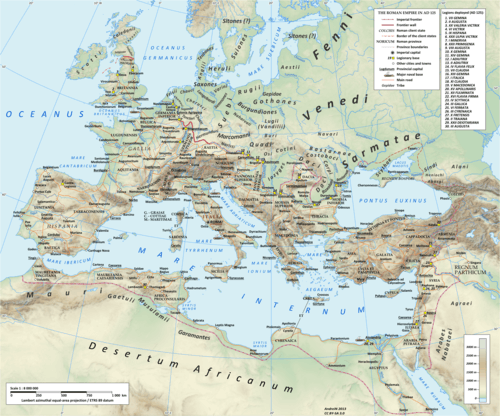Sarmatians
The Sarmatians (/sɑːrˈmeɪʃiənz/; Persian: سرم ها; Latin: Sarmatae, Sauromatae; Greek: Σαρμάται, Σαυρομάται) were a large Iranian confederation that existed in classical antiquity, flourishing from about the 5th century BC to the 4th century AD.
Part of a series on the |
|---|
| History of Ukraine |
 |
|
Early history
|
|
Modern history
|
|
Topics by history |
|
|
Part of a series on the |
||||||||||||||||||||||||||
|---|---|---|---|---|---|---|---|---|---|---|---|---|---|---|---|---|---|---|---|---|---|---|---|---|---|---|
| History of Russia | ||||||||||||||||||||||||||
 | ||||||||||||||||||||||||||
|
||||||||||||||||||||||||||
| Timeline | ||||||||||||||||||||||||||
|
| ||||||||||||||||||||||||||
| Part of a series on |
| Indo-European topics |
|---|
 |
|
|
Philology
|
|
Origins |
|
Archaeology Pontic Steppe
Caucasus East Asia Eastern Europe Northern Europe Pontic Steppe Northern/Eastern Steppe Europe
South Asia Steppe Europe Caucasus India |
|
Peoples and societies Indo-Aryans Iranians
East Asia Europe East Asia Europe
Indo-Aryan Iranian
|
|
Religion and mythology
Indo-Aryan Iranian Others Europe
|
|
Originating in the central parts of the Eurasian Steppe, the Sarmatians were part of the wider Scythian cultures.[1] They started migrating westward around the 4th and 3rd centuries BC, coming to dominate the closely related Scythians by 200 BC. At their greatest reported extent, around 1st century AD, these tribes ranged from the Vistula River to the mouth of the Danube and eastward to the Volga, bordering the shores of the Black and Caspian seas as well as the Caucasus to the south.
Their territory, which was known as Sarmatia (/sɑːrˈmeɪʃiə/) to Greco-Roman ethnographers, corresponded to the western part of greater Scythia (it included today's Central Ukraine, South-Eastern Ukraine, Southern Russia, Russian Volga and South-Ural regions, also to a smaller extent north-eastern Balkans and around Moldova). In the 1st century AD, the Sarmatians began encroaching upon the Roman Empire in alliance with Germanic tribes. In the 3rd century AD, their dominance of the Pontic Steppe was broken by the Germanic Goths. With the Hunnic invasions of the 4th century, many Sarmatians joined the Goths and other Germanic tribes (Vandals) in the settlement of the Western Roman Empire. Since large parts of today's Russia, specifically the land between the Ural Mountains and the Don River, were controlled in the 5th century BC by the Sarmatians, the Volga–Don and Ural steppes sometimes are also called "Sarmatian Motherland".[2][3]
The Sarmatians were eventually decisively assimilated (e.g. Slavicisation) and absorbed by the Proto-Slavic population of Eastern Europe.[4]
Etymology
Sarmatae probably originated as just one of several tribal names of the Sarmatians, but one that Greco-Roman ethnography came to apply as an exonym to the entire group. Strabo in the 1st century names as the main tribes of the Sarmatians the Iazyges, the Roxolani, the Aorsi and the Siraces.
The Greek name Sarmatai sometimes appears as "Sauromatai", which is almost certainly no more than a variant of the same name. Nevertheless, historians often regarded these as two separate peoples, while archaeologists habitually use the term 'Sauromatian' to identify the earliest phase of Sarmatian culture. Any idea that the name derives from the word lizard (sauros), linking to the Sarmatians' use of reptile-like scale armour and dragon standards, is almost certainly unfounded.[5]
Both Pliny the Elder (Natural History book iv) and Jordanes recognised the Sar- and Sauro- elements as interchangeable variants, referring to the same people. Greek authors of the 4th century (Pseudo-Scylax, Eudoxus of Cnidus) mention Syrmatae as the name of a people living at the Don, perhaps reflecting the ethnonym as it was pronounced in the final phase of Sarmatian culture.
English scholar Harold Walter Bailey (1899–1996) derived the base word from Avestan sar- (to move suddenly) from tsar- in Old Iranian (tsarati, tsaru-, hunter), which also gave its name to the western Avestan region of Sairima (*salm, – *Sairmi), and also connected it to the 10–11th century AD Persian epic Shahnameh's character "Salm".[6]
Oleg Trubachyov derived the name from the Indo-Aryan *sar-ma(n)t (feminine – rich in women, ruled by women), the Indo-Aryan and Indo-Iranian word *sar- (woman) and the Indo-Iranian adjective suffix -ma(n)t/wa(n)t.[7] By this derivation was noted the unusual high status of women (matriarchy) from the Greek point of view and went to the invention of Amazons (thus the Greek name for Sarmatians as Sarmatai Gynaikokratoumenoi, ruled by women).[7]
Ethnology
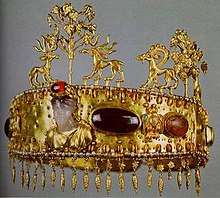
The Sarmatians were part of the Iranian steppe peoples, among whom were also Scythians and Saka.[8] These are also grouped together as "East Iranians".[9] Archaeology has established the connection 'between the Iranian-speaking Scythians, Sarmatians and Saka and the earlier Timber-grave and Andronovo cultures'.[10] Based on building construction, these three peoples were the likely descendants of those earlier archaeological cultures.[11] The Sarmatians and Saka used the same stone construction methods as the earlier Andronovo culture.[12] The Timber grave (Srubnaya culture) and Andronovo house building traditions were further developed by these three peoples.[13] Andronovo pottery was continued by the Saka and Sarmatians.[14] Archaeologists describe the Andronovo culture people as exhibiting pronounced Caucasoid features.[15]
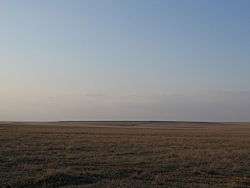
The first Sarmatians are mostly identified with the Prokhorovka culture, which moved from the southern Urals to the Lower Volga and then northern Pontic steppe, in the 4th–3rd centuries BC. During the migration, the Sarmatians seem to have grown and divided themselves into several groups, such as the Alans, Aorsi, Roxolani, and Iazyges. By 200 BC, the Sarmatians replaced the Scythians as the dominant people of the steppes.[16] The Sarmatians and Scythians had fought on the Pontic steppe to the north of the Black Sea.[17] The Sarmatians, described as a large confederation,[18] were to dominate these territories over the next five centuries.[19] According to Brzezinski and Mielczarek, the Sarmatians were formed between the Don River and the Ural Mountains.[19] Pliny the Elder (23–79 AD) wrote that they ranged from the Vistula River (in present-day Poland) to the Danube.
The Sarmatians differed from the Scythians in their veneration of the god of fire rather than god of nature, and women's prominent role in warfare, which possibly served as the inspiration for the Amazons.
Origin
The two theories about the origin of the Sarmatian culture are:
- The Sarmatian culture was fully formed by the end of the fourth century BC, based on the combination of local Sauromatian culture of Southern Ural and foreign elements brought by tribes advancing from the forest-steppe Zauralye (Itkul culture, Gorohovo culture), from Kazakhstan and possibly from the Aral Sea region.[20] Sometime between the fourth and third century BC, a mass migration carried nomads of the Southern Ural to the west in the Lower Volga and a smaller migration to the north, south, and east. In the Lower Volga, Eastern nomads either partly assimilated local Sauromatian tribes, or pushed them into the Azov Sea and the Western Caucasus, where they subsequently formed a basis of nomadic association. A merging of the Southern Ural Prokhorovka culture with the Lower Volga or Sauromatian culture defines local differences between Prokhorovka monuments of Southern Ural and the Volga–Don region within a single culture.
- The Sarmatian culture in the Southern Ural evolved from the early Prokhorovka culture. The culture of the Lower Volga Sauromates developed at the same time as an independent community.[21]
Archaeology
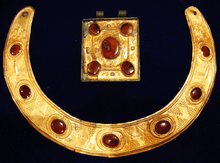
In 1947, Soviet archaeologist Boris Grakov defined a culture flourishing from the 6th century BC to the 4th century AD, apparent in late kurgan graves (buried within earthwork mounds), sometimes reusing part of much older kurgans.[22] It was a nomadic steppe culture ranging from the Black Sea eastward to beyond the Volga, and is especially evident at two of the major sites at Kardaielova and Chernaya in the trans-Uralic steppe. The four phases – distinguished by grave construction, burial customs, grave goods, and geographic spread – are:[18][23]
- Sauromatian, 6th–5th centuries BC
- Early Sarmatian, 4th–2nd centuries BC, also called the Prokhorovka culture
- Middle Sarmatian, late 2nd century BC to late 2nd century AD
- Late Sarmatian: late 2nd century AD to 4th century AD
While "Sarmatian" and "Sauromatian" are synonymous as ethnonyms, they are given different meanings purely by convention as archaeological technical terms. The term "Prokhorovka culture" derives from a complex of mounds in the Prokhorovski District, Orenburg region, excavated by S. I. Rudenko in 1916.[24]
In Hungary, a great Late Sarmatian pottery centre was reportedly unearthed between 2001 and 2006 near Budapest, in the Üllő5 archaeological site. Typical grey, granular Üllő5 ceramics form a distinct group of Sarmatian pottery found everywhere in the north-central part of the Great Hungarian Plain region, indicating a lively trading activity. A 1998 paper on the study of glass beads found in Sarmatian graves suggests wide cultural and trade links.[25]
Archaeological evidence suggests that Scythian-Sarmatian cultures may have given rise to the Greek legends of Amazons. Graves of armed females have been found in southern Ukraine and Russia. David Anthony notes, "About 20% of Scythian-Sarmatian "warrior graves" on the lower Don and lower Volga contained females dressed for battle as if they were men, a phenomenon that probably inspired the Greek tales about the Amazons."[26]
Language
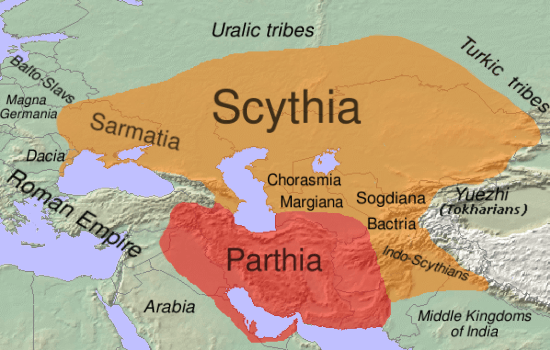
The Sarmatians spoke an Iranian language, derived from 'Old Iranian', that was heterogenous. By the 1st century BC, the Iranian tribes in what is today South Russia spoke different languages or dialects, clearly distinguishable.[27] According to a group of Iranologists writing in 1968, the numerous Iranian personal names in Greek inscriptions from the Black Sea coast indicated that the Sarmatians spoke a North-Eastern Iranian dialect ancestral to Alanian-Ossetian.[28] However, Harmatta (1970) argued that "the language of the Sarmatians or that of the Alans as a whole cannot be simply regarded as being Old Ossetian".[27]
Genetics
In a study conducted in 2014 by Gennady Afanasiev et al. on bone fragments from ten Alanic burials on the Don River, DNA was extracted from seven. Four of them turned out to belong to yDNA Haplogroup G2 and six of them possessed mtDNA haplogroup I.[29]
In 2015, the Institute of Archaeology in Moscow conducted research on various Sarmato-Alan and Saltovo-Mayaki culture Kurgan burials. In these analyses, the two Alan samples from the 4th to 6th century AD turned out to belong to yDNA haplogroups G2a-P15 and R1a-z94, while two of the three Sarmatian samples from the 2nd to 3rd century AD were found to belong to yDNA haplogroup J1-M267 while one belonged to R1a.[30] Three Saltovo-Mayaki samples from the 8th to 9th century AD turned out to have yDNA corresponding to haplogroups G, J2a-M410 and R1a-z94.[31]
A genetic study published in Nature in May 2018 examined the remains of twelve Sarmatians buried between 400 BC and 400 AD. The Y-DNA extracted were two samples of R, one sample of haplogroup R1a1, one sample of I2b and one sample of R1. The mtDNA extracted were one sample of C4a1a, two samples of U4a2, one sample of C4b1, one sample of I1, two samples of A, two samples of U2e1h, one sample of U4b1a4, one sample of H28, and one sample of U5a1.[32]
In 2018, a genetic study of the earlier Srubnaya culture, and later peoples of the Scythian cultures, including the Sarmatians, was published in Science Advances. While members of the Srubnaya culture were found to be carriers of haplogroup R1a1a1, which showed a major expansion during the Bronze Age, the Sarmatians studies were found to be exclusively carriers of haplogroup R1b1a1a2, except from one Sarmatian who was found to be carrying haplogroup R1a1a1.[33]
In 2019, a genetic study of various peoples belonging to the Scythian cultures, including the Sarmatians, was published in Current Biology. The Sarmatian remains analyzed were mostly found to be carriers of haplogroup R1a and various subclades of it.[34]
Appearance
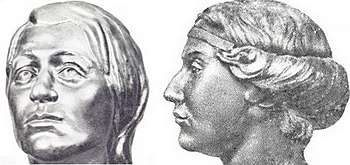
In the late 2nd or early 3rd century AD, the Greek physician Galen declared that Sarmatians, Scythians and other northern peoples had reddish hair.[35] They are said to owe their name (Sarmatae) to it.[36]
The Alans were a group of Sarmatian tribes, according to the Roman historian Ammianus Marcellinus. He wrote, "Nearly all the Alani are men of great stature and beauty, their hair is somewhat yellow, their eyes are frighteningly fierce".[19]
Greco-Roman ethnography
Herodotus (Histories 4.21) in the 5th century BC placed the land of the Sarmatians east of the Tanais, beginning at the corner of the Maeotian Lake, stretching northwards for fifteen days' journey, adjacent to the forested land of the Budinoi.
Herodotus (4.110–117) recounts that the Sauromatians arose from marriages of a group of Amazons and young Scythian men. In the story, some Amazons were captured in battle by Greeks in Pontus (northern Turkey) near the river Thermodon, and the captives were loaded into three boats. They overcame their captors while at sea, but were not able sailors. Their ships were blown north to the Maeotian Lake (the Sea of Azov) onto the shore of Scythia near the cliff region (today's southeastern Crimea). After encountering the Scythians and learning the Scythian language, they agreed to marry Scythian men, but only on the condition that they move away and not be required to follow the customs of Scythian women. According to Herodotus, the descendants of this band settled toward the northeast beyond the Tanais (Don) river and became the Sauromatians. Herodotus' account explains the origins of their language as an "impure" form of Scythian. He credits the unusual social freedoms of Sauromatae women, including participation in warfare, as an inheritance from their Amazon ancestors. Later writers refer to the "woman-ruled Sarmatae" (γυναικοκρατούμενοι).[37]
Herodotus (4.118–144) later relates how the Sauromatians answered the Scythian call for help against the Persian King Darius I, to repel his campaign in Scythia, along with the Gelonians and the Boudinians. The Persians invaded much of the Sauromatian territory, but were eventually forced to withdraw due the tribespeoples' tactics of delay and use of a scorched earth policy.[38]
Hippocrates[39] explicitly classes them as Scythian and describes their warlike women and their customs:
Their women, so long as they are virgins, ride, shoot, throw the javelin while mounted, and fight with their enemies. They do not lay aside their virginity until they have killed three of their enemies, and they do not marry before they have performed the traditional sacred rites. A woman who takes to herself a husband no longer rides, unless she is compelled to do so by a general expedition. They have no right breast; for while they are yet babies their mothers make red-hot a bronze instrument constructed for this very purpose and apply it to the right breast and cauterize it, so that its growth is arrested, and all its strength and bulk are diverted to the right shoulder and right arm.
Polybius (XXV, 1) mentions them for the first time as a force to be reckoned with in 179 B.C.[17]
Strabo[40] mentions the Sarmatians in a number of places, but never says much about them. He uses both the terms of Sarmatai and Sauromatai, but never together, and never suggesting that they are different peoples. He often pairs Sarmatians and Scythians in reference to a series of ethnic names, never stating which is which, as though Sarmatian or Scythian could apply equally to them all.[41]
Strabo wrote that the Sarmatians extend from above the Danube eastward to the Volga, and from north of the Dnieper River into the Caucasus, where, he says, they are called Caucasii like everyone else there. This statement indicates that the Alans already had a home in the Caucasus, without waiting for the Huns to push them there.
Even more significantly, he points to a Celtic admixture in the region of the Basternae, who, he said, were of Germanic origin. The Celtic Boii, Scordisci and Taurisci are there. A fourth ethnic element interacting and intermarrying are the Thracians (7.3.2). Moreover, the peoples toward the north are Keltoskythai, "Celtic Scythians" (11.6.2).
Strabo portrays the peoples of the region as being nomadic, or Hamaksoikoi, "wagon-dwellers", and Galaktophagoi, "milk-eaters". This latter likely referred to the universal koumiss eaten in historical times. The wagons were used for transporting tents made of felt, a type of the yurts used universally by Asian nomads.
Pliny the Elder writes (4.12.79–81):
From this point (the mouth of the Danube) all the races in general are Scythian, though various sections have occupied the lands adjacent to the coast, in one place the Getae ... at another the Sarmatae ... Agrippa describes the whole of this area from the Danube to the sea ... as far as the river Vistula in the direction of the Sarmatian desert ... The name of the Scythians has spread in every direction, as far as the Sarmatae and the Germans, but this old designation has not continued for any except the most outlying sections ...
According to Pliny, Scythian rule once extended as far as Germany. Jordanes supports this hypothesis by telling us on the one hand that he was familiar with the Geography of Ptolemy, which includes the entire Balto-Slavic territory in Sarmatia, and on the other that this same region was Scythia. By "Sarmatia", Jordanes means only the Aryan territory. The Sarmatians were, therefore, a sub-group of the broader Scythian peoples.
Tacitus' De Origine et situ Germanorum speaks of "mutual fear" between Germanic peoples and Sarmatians:
All Germania is divided from Gaul, Raetia, and Pannonia by the Rhine and Danube rivers; from the Sarmatians and the Dacians by shared fear and mountains. The Ocean laps the rest, embracing wide bays and enormous stretches of islands. Just recently, we learned about certain tribes and kings, whom war brought to light.[42]
According to Tacitus, like the Persians, the Sarmatians wore long, flowing robes (ch 17). Moreover, the Sarmatians exacted tribute from the Cotini and Osi, and iron from the Cotini (ch. 43), "to their shame" (presumably because they could have used the iron to arm themselves and resist).
.jpg)
By the 3rd century BC, the Sarmatian name appears to have supplanted the Scythian in the plains of what is now south Ukraine. The geographer, Ptolemy, reports them at what must be their maximum extent, divided into adjoining European and central Asian sections. Considering the overlap of tribal names between the Scythians and the Sarmatians, no new displacements probably took place. The people were the same Indo-Europeans, but were referred to under yet another name.
Later, Pausanias, viewing votive offerings near the Athenian Acropolis in the 2nd century AD,[43] found among them a Sauromic breastplate.
On seeing this a man will say that no less than Greeks are foreigners skilled in the arts: for the Sauromatae have no iron, neither mined by themselves nor yet imported. They have, in fact, no dealings at all with the foreigners around them. To meet this deficiency they have contrived inventions. In place of iron they use bone for their spear-blades and cornel wood for their bows and arrows, with bone points for the arrows. They throw a lasso round any enemy they meet, and then turning round their horses upset the enemy caught in the lasso. Their breastplates they make in the following fashion. Each man keeps many mares, since the land is not divided into private allotments, nor does it bear any thing except wild trees, as the people are nomads. These mares they not only use for war, but also sacrifice them to the local gods and eat them for food. Their hoofs they collect, clean, split, and make from them as it were python scales. Whoever has never seen a python must at least have seen a pine-cone still green. He will not be mistaken if he liken the product from the hoof to the segments that are seen on the pine-cone. These pieces they bore and stitch together with the sinews of horses and oxen, and then use them as breastplates that are as handsome and strong as those of the Greeks. For they can withstand blows of missiles and those struck in close combat.
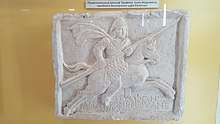
Pausanias' description is well borne out in a relief from Tanais (see image). These facts are not necessarily incompatible with Tacitus, as the western Sarmatians might have kept their iron to themselves, its having been a scarce commodity on the plains.
In the late 4th century, Ammianus Marcellinus[44] describes a severe defeat which Sarmatian raiders inflicted upon Roman forces in the province of Valeria in Pannonia in late AD 374. The Sarmatians almost destroyed two legions: one recruited from Moesia and one from Pannonia. The latter had been sent to intercept a party of Sarmatians which had been in pursuit of a senior Roman officer named Aequitius. The two legions failed to coordinate, allowing the Sarmatians to catch them unprepared.
Decline in the 4th century
The Sarmatians remained dominant until the Gothic ascendancy in the Black Sea area (Oium). Goths attacked Sarmatian tribes on the north of the Danube in Dacia, in present-day Romania. The Roman Emperor Constantine I (r. 306–337) summoned his son Constantine II from Gallia to campaign north of the Danube. In 332, in very cold weather, the Romans were victorious, killing 100,000 Goths and capturing Ariaricus, the son of the Gothic king. In their efforts to halt the Gothic expansion and replace it with their own on the north of Lower Danube (present-day Romania), the Sarmatians armed their "servants" Limigantes. After the Roman victory, however, the local population revolted against their Sarmatian masters, pushing them beyond the Roman border. Constantine, on whom the Sarmatians had called for help, defeated the Limigantes, and moved the Sarmatian population back in. In the Roman provinces, Sarmatian combatants enlisted in the Roman army, whilst the rest of the population sought refuge throughout Thrace, Macedonia and Italy. The Origo Constantini mentions 300,000 refugees resulting from this conflict. The Emperor Constantine was subsequently attributed the title of Sarmaticus Maximus.[45]
In the 4th and 5th centuries the Huns expanded and conquered both the Sarmatians and the Germanic tribes living between the Black Sea and the borders of the Roman Empire. From bases in modern-day Hungary, the Huns ruled the entire former Sarmatian territory. Their various constituents flourished under Hunnish rule, fought for the Huns against a combination of Roman and Germanic troops, and departed after the Battle of Chalons (451), the death of Attila (453) and the appearance of the Bulgar ruling elements west of the Volga.
Eventually the Proto-Slavic population of Eastern Europe decisively assimilated and absorbed the Sarmatians around the Early Medieval Age.[46][47] A related people to the Sarmatians, known as the Alans, survived in the North Caucasus into the Early Middle Ages, ultimately giving rise to the modern Ossetic ethnic group.[48]
Legacy
Sarmatism
Sarmatism (or Sarmatianism) is an ethno-cultural concept with a shade of politics designating the formation of an idea of Poland's origin from Sarmatians within the Polish-Lithuanian Commonwealth.[49] The dominant Baroque culture and ideology of the nobility (szlachta) that existed in times of the Renaissance to the 18th centuries.[49] Together with another concept of "Golden Liberty", it formed a central aspect of the Commonwealth's culture and society. At its core was the unifying belief that the people of the Polish Commonwealth descended from the ancient Iranic Sarmatians, the legendary invaders of Slavic lands in antiquity.[50][51]
Tribes
References
- Unterländer, Martina (March 3, 2017). "Ancestry and demography and descendants of Iron Age nomads of the Eurasian Steppe". Nature Communications. 8: 14615. doi:10.1038/ncomms14615. PMC 5337992. PMID 28256537.
During the first millennium BCE, nomadic people spread over the Eurasian Steppe from the Altai Mountains over the northern Black Sea area as far as the Carpathian Basin... Greek and Persian historians of the 1st millennium BCE chronicle the existence of the Massagetae and Sauromatians, and later, the Sarmatians and Sacae: cultures possessing artefacts similar to those found in classical Scythian monuments, such as weapons, horse harnesses and a distinctive ‘Animal Style' artistic tradition. Accordingly, these groups are often assigned to the Scythian culture...
CS1 maint: ref=harv (link) - "Sarmatian | people". Encyclopedia Britannica.
- Kozlovskaya, Valeriya (2017). The Northern Black Sea in antiquity : networks, connectivity, and cultural interactions. Kozlovskaya, Valeriya, 1972-. Cambridge, United Kingdom. ISBN 9781108517614. OCLC 1000597862.
- Tarasov, Илья Тарасов / Ilia. "Балты в миграциях Великого переселения народов. Галинды // Исторический формат, № 3-4, 2017. С. 95-124". Балты в миграциях Великого переселения народов. Галинды – via www.academia.edu.
- Brzezinski & Mielczarek 2002, p. 6.
- Bailey, Harold Walter (1985). Khotanese Text. Cambridge University Press. p. 65. ISBN 9780521257794.
- Gluhak, Alemko (1990), "Podrijetlo imena Hrvat" [The origin of the ethnonym Hrvat], Jezik : Periodical for the Culture of the Standard Croatian Language (in Croatian), 37 (5): 131–133
- Kuzmina 2007, p. 220.
- Kuzmina 2007, p. 445.
- Kuzmina 2007, p. xiv.
- Kuzmina 2007, p. 50.
- Kuzmina 2007, p. 51.
- Kuzmina 2007, p. 64.
- Kuzmina 2007, p. 78.
- Keyser, Christine; Bouakaze, Caroline; Crubézy, Eric; Nikolaev, Valery G.; Montagnon, Daniel; Reis, Tatiana; Ludes, Bertrand (May 16, 2009). "Ancient DNA provides new insights into the history of south Siberian Kurgan people". Human Genetics. 126 (3): 395–410. doi:10.1007/s00439-009-0683-0. PMID 19449030.
- Barry W. Cunliffe (2001). The Oxford Illustrated History of Prehistoric Europe. Oxford University Press. pp. 402–. ISBN 978-0-19-285441-4.
- Grousset, Rene (1970). The Empire of the Steppes. Rutgers University Press. pp. 15. ISBN 978-0-8135-1304-1.
- Sinor 1990, p. 113.
- Brzezinski & Mielczarek 2002.
- Мошкова М. Г. Памятники прохоровской культуры//САИ, 1963. Д. 1–10
- Уральская историческая энциклопедия. — УрО РАН, Институт истории и археологии. Екатеринбург: Академкнига. Гл. ред. В. В. Алексеев. 2000.
- Граков Б. Н. ГYNAIKOKPATOYMENOI (Пережитки матриархата у сарматов)//ВДИ, 1947. № 3
- Genito, Bruno (1 November 2002). The Elusive Frontiers of the Eurasian Steppes. All’Insegna del Giglio. pp. 57–. ISBN 978-88-7814-283-1.
- Yablonskii, Leonid; Balakhvantsev, Archil (1 January 2009). "A Silver Bowl from the New Excavations of the Early Sarmatian Burial-Ground Near the Village of Prokhorovka". Ancient Civilizations from Scythia to Siberia. 15 (1–2): 167–169. doi:10.1163/092907709X12474657004809.
- "Chemical Analyses of Sarmatian Glass Beads from Pokrovka, Russia" Archived 2005-04-15 at the Library of Congress Web Archives, by Mark E. Hall and Leonid Yablonsky.
- Anthony, David W. (2007). The Horse, the Wheel, and Language: How Bronze-Age Riders from the Eurasian Steppes Shaped the Modern World. Princeton University Press. ISBN 978-0-691-05887-0.
- Harmatta 1970, 3.4.
- Handbuch der Orientalistik, Iranistik. By I. Gershevitch, O. Hansen, B. Spuler, M.J. Dresden, Prof M Boyce, M. Boyce Summary. E.J. Brill. 1968.
- Reshetova, Irina; Afanasiev, Gennady. "Афанасьев Г.Е., Добровольская М.В., Коробов Д.С., Решетова И.К. О культурной, антропологической и генетической специфике донских алан // Е.И. Крупнов и развитие археологии Северного Кавказа. М. 2014. С. 312-315" – via www.academia.edu. Cite journal requires
|journal=(help) - дДНК Сарматы, Аланы Google Maps
- Reshetova, Irina; Afanasiev, Gennady. "Афанасьев Г.Е., Вень Ш., Тун С., Ван Л., Вэй Л., Добровольская М.В., Коробов Д.С., Решетова И.К., Ли Х.. Хазарские конфедераты в бассейне Дона // Естественнонаучные методы исследования и парадигма современной археологии. М. 2015. С.146-153" – via www.academia.edu. Cite journal requires
|journal=(help) - Damgaard et al. 2018.
- Krzewińska, Maja (October 3, 2018). "Ancient genomes suggest the eastern Pontic-Caspian steppe as the source of western Iron Age nomads". Nature Communications. 4 (10): eaat4457. doi:10.1126/sciadv.aat4457. PMC 6223350.CS1 maint: ref=harv (link)
- Järve, Mari (July 22, 2019). "Shifts in the Genetic Landscape of the Western Eurasian Steppe Associated with the Beginning and End of the Scythian Dominance". Current Biology. 29 (14): 2430–2441. doi:10.1016/j.cub.2019.06.019.
R1a is also the predominant lineage among Cimmerians, Scy_Ukr and ScySar_SU in our data...
CS1 maint: ref=harv (link) - Day 2001, pp. 55–57.
- Baumgarten, Siegmund Jakob; Beer, Ferdinand Wilhelm; Semler, Johann Salomo (1760). A Supplement to the English Universal History: Lately Published in London: Containing ... Remarks and Annotations on the Universal History, Designed as an Improvement and Illustration of that Work ... E. Dilly. p. 30.
- Periplus of Pseudo-Scylax, 70; cf. Geographi Graeci minores: Volume 1, p.58
- Herodotus' Histories, book IV
- De Aere XVII
- Strabo's Geography, books V, VII, XI
- J. Harmatta, Studies in the History and Language of the Sarmatians, 1970, ch.1.2
- Germania omnis a Gallis Raetisque et Pannoniis Rheno et Danuvio fluminibus, a Sarmatis Dacisque mutuo metu aut montibus separatur: cetera Oceanus ambit, latos sinus et insularum inmensa spatia complectens, nuper cognitis quibusdam gentibus ac regibus, quos bellum aperuit.
- Description of Greece 1.21.5–6
- Amm. Marc. 29.6.13–14
- Eusebius. "IV.6". Life of Constantine.; *Valois, Henri, ed. (1636) [ca. 390]. "6.32". Anonymus Valesianus I/Origo Constantini Imperatoris.
- Brzezinski & Mielczarek 2002, p. 39.
- Slovene Studies. 9–11. Society for Slovene Studies. 1987. p. 36.
(..) For example, the ancient Scythians, Sarmatians (amongst others), and many other attested but now extinct peoples were assimilated in the course of history by Proto-Slavs.
-
Minahan, James (2000). "Ossetians". One Europe, Many Nations: A Historical Dictionary of European National Groups. Praeger security international. Westport, Connecticut: Greenwood Publishing Group. p. 518. ISBN 9780313309847. Retrieved 27 March 2020.
The Ossetians, calling themselves Iristi and their homeland Iryston, are the most northerly of the Iranian peoples. [...] They are descended from a division of Sarmatians, the Alans, who were pushed out of the Terek River lowlands and into the Caucasus foothills by invading Huns in the fourth century A.D.
- Kresin, O. Sarmatism Ukrainian. Ukrainian History
- Tadeusz Sulimirski, The Sarmatians (New York: Praeger Publishers 1970) at 167.
- P. M. Barford, The Early Slavs (Ithaca: Cornell University 2001) at 28.
Sources
- Books
- Brzezinski, Richard; Mielczarek, Mariusz (2002). The Sarmatians 600 BC–AD 450. Men-At-Arms (373). Bloomsbury USA; Osprey Publishing. ISBN 978-1-84176-485-6.CS1 maint: ref=harv (link)
- Davis-Kimball, Jeannine; Bashilov, Vladimir A.; Yablonsky, Leonid T. (1995). Nomads of the Eurasian Steppes in the Early Iron Age. Berkeley: Zinat Press. ISBN 978-1-885979-00-1.
- Day, John V. (2001). Indo-European origins: the anthropological evidence. Institute for the Study of Man. ISBN 978-0941694759.CS1 maint: ref=harv (link)
- Hinds, Kathryn (2009). Scythians and Sarmatians. Marshall Cavendish. ISBN 978-0-7614-4519-7.CS1 maint: ref=harv (link)
- Istvánovits, Eszter; Kulcsár, Valéria (2017). Sarmatians: History and Archaeology of a Forgotten People. Schnell & Steiner. ISBN 978-3-7954-3234-8.CS1 maint: ref=harv (link)
- Kozlovskaya, Valeriya (2017). The Northern Black Sea in Antiquity. Cambridge University Press. ISBN 978-1-107-01951-5.
- Kuzmina, Elena Efimovna (2007). The Origin of the Indo-Iranians. BRILL. pp. 50, 51, 56, 64, 78, 83, 220, 410. ISBN 978-90-04-16054-5.CS1 maint: ref=harv (link)
- Sinor, Denis, ed. (1990). The Cambridge History of Early Inner Asia. Cambridge University Press. ISBN 978-0-521-24304-9.CS1 maint: ref=harv (link)
- К.Ф. Смирнов. Сарматы и утверждение их политического господства в Скифии. Рипол Классик. ISBN 978-5-458-40072-5.
- Sulimirski, Tadeusz (1970). The Sarmatians. Ancient People and Places, vol. 73. Praeger.CS1 maint: ref=harv (link)
- Journals
- Абрамова, М. П. (1988). "Сарматы и Северный Кавказ". Проблемы сарматской археологии и истории: 4–18.
- Damgaard, P. B.; et al. (May 9, 2018). "137 ancient human genomes from across the Eurasian steppes". Nature. Nature Research. 557 (7705): 369–373. doi:10.1038/s41586-018-0094-2. PMID 29743675. Retrieved April 11, 2020.
- Genito, Bruno (1988). "The Archaeological Cultures of the Sarmatians with a Preliminary Note on the Trial-Trenches at Gyoma 133: a Sarmatian Settlement in South-Eastern Hungary (Campaign 1985)" (PDF). Annali dell'Istituto Universitario Orientale di Napoli. 42: 81–126.
- Harmatta, J. (1970). "Studies in the History and Language of the Sarmatians". Acta Antique et Archaeologica. XIII.CS1 maint: ref=harv (link)
- Клепиков, В. М.; Скрипкин, А. С. (1997). "Ранние сарматы в контексте исторических событий Восточной Европы". Донские древности. 5: 28–40.
- Козлова, Р. М. (2004). О Сормах, Сарматах, Сорматских горах. Студії з ономастики та етимології (in Ukrainian).CS1 maint: ref=harv (link)
- Lebedynsky, Iaroslav (2002). Les Sarmates: amazones et lanciers cuirassés entre Oural et Danube, VIIe siècle av. J.-C.-VIe siècle apr. J.-C. Errance. ISBN 978-2-87772-235-3.
- Mordvintseva, Valentina I. (2015). "Сарматы, Сарматия и Северное Причерноморье" [Sarmatia, the Sarmatians and the North Pontic Area] (PDF). Вестник древней истории [Journal of Ancient History]. 1 (292): 109–135.
- Mordvintseva, Valentina I. (2013). "The Sarmatians: The Creation of Archaeological Evidence". Oxford Journal of Archaeology. 32 (2): 203–219. doi:10.1111/ojoa.12010.
- Moshkova, M. G. (1995). "A brief review of the history of the Sauromatian and Sarmatian tribes". Nomads of the Eurasian Steppes in the Early Iron Age: 85–89.
- Perevalov, S. M. (2002). "The Sarmatian Lance and the Sarmatian Horse-Riding Posture". Anthropology & Archeology of Eurasia. 40 (4): 7–21. doi:10.2753/aae1061-195940047.
- Rjabchikov, Sergei V. (2004). "Remarks on the Scythian, Sarmatian and Meotian Beliefs". AnthroGlobe Journal.
- Симоненко, А. В.; Лобай, Б. И. (1991). "Сарматы Северо-Западного Причерноморья в I в. н. э.". Погребения знати у с. Пороги (in Russian).
External links
| Wikimedia Commons has media related to Sarmatians. |
- Yatsenko, S. A. (1992). "CLOTHING vii. Of the Iranian Tribes on the Pontic Steppes and in the Caucaus". CLOTHING vii. Of the Iranian Tribes – Encyclopaedia Iranica. Encyclopaedia Iranica, Vol. V, Fasc. 7. pp. 758–760.CS1 maint: ref=harv (link)
- Ptolemaic Map (Digital Scriptorium)
- Kurgans, Ritual Sites, and Settlements: Eurasian Bronze and Iron Age
- Nomadic Art of the Eastern Eurasian Steppes, an exhibition catalog from The Metropolitan Museum of Art (fully available online as PDF), which contains material on Sarmatians
